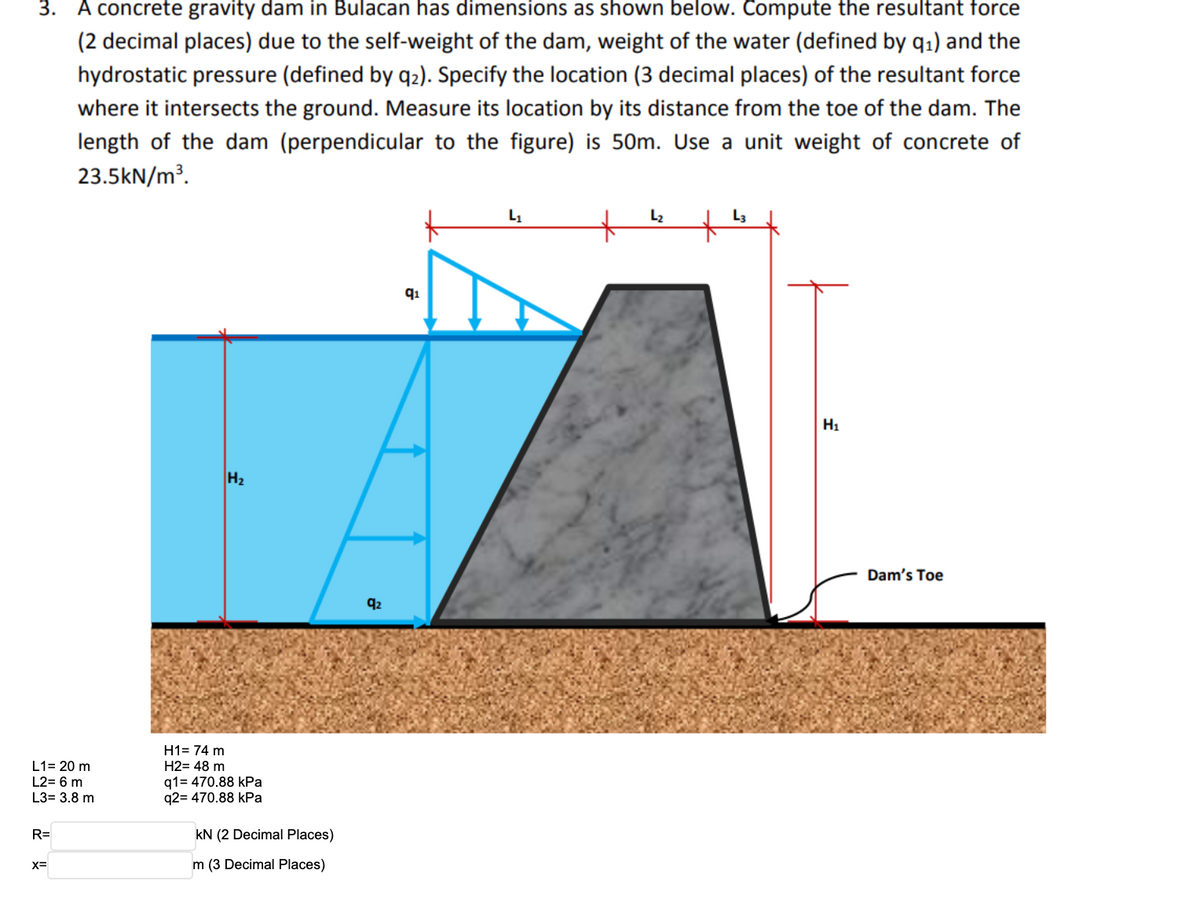3. A concrete gravity dam in Bulacan has dimensions as shown below. Compute the resultant force (2 decimal places) due to the self-weight of the dam, weight of the water (defined by q1) and the hydrostatic pressure (defined by q2). Specify the location (3 decimal places) of the resultant force where it intersects the ground. Measure its location by its distance from the toe of the dam. The length of the dam (perpendicular to the figure) is 50m. Use a unit weight of concrete of 23.5kN/m². L1 L2 L3 q1 H1 H2 Dam's Toe 92 H1= 74 m L1= 20 m L2= 6 m L3= 3.8 m H2= 48 m q1= 470.88 kPa q2= 470.88 kPa R= kN (2 Decimal Places) X= m (3 Decimal Places)
3. A concrete gravity dam in Bulacan has dimensions as shown below. Compute the resultant force (2 decimal places) due to the self-weight of the dam, weight of the water (defined by q1) and the hydrostatic pressure (defined by q2). Specify the location (3 decimal places) of the resultant force where it intersects the ground. Measure its location by its distance from the toe of the dam. The length of the dam (perpendicular to the figure) is 50m. Use a unit weight of concrete of 23.5kN/m². L1 L2 L3 q1 H1 H2 Dam's Toe 92 H1= 74 m L1= 20 m L2= 6 m L3= 3.8 m H2= 48 m q1= 470.88 kPa q2= 470.88 kPa R= kN (2 Decimal Places) X= m (3 Decimal Places)
Chapter2: Loads On Structures
Section: Chapter Questions
Problem 1P
Related questions
Question

Transcribed Image Text:3. A concrete gravity dam in Bulacan has dimensions as shown below. Compute the resultant force
(2 decimal places) due to the self-weight of the dam, weight of the water (defined by q1) and the
hydrostatic pressure (defined by q2). Specify the location (3 decimal places) of the resultant force
where it intersects the ground. Measure its location by its distance from the toe of the dam. The
length of the dam (perpendicular to the figure) is 50m. Use a unit weight of concrete of
23.5kN/m?.
L1
L2
q1
H1
H2
Dam's Toe
q2
H1= 74 m
H2= 48 m
L1= 20 m
L2= 6 m
L3= 3.8 m
q1= 470.88 kPa
q2= 470.88 kPa
R=
kN (2 Decimal Places)
X=
m (3 Decimal Places)
Expert Solution
This question has been solved!
Explore an expertly crafted, step-by-step solution for a thorough understanding of key concepts.
This is a popular solution!
Trending now
This is a popular solution!
Step by step
Solved in 2 steps with 2 images

Recommended textbooks for you


Structural Analysis (10th Edition)
Civil Engineering
ISBN:
9780134610672
Author:
Russell C. Hibbeler
Publisher:
PEARSON

Principles of Foundation Engineering (MindTap Cou…
Civil Engineering
ISBN:
9781337705028
Author:
Braja M. Das, Nagaratnam Sivakugan
Publisher:
Cengage Learning


Structural Analysis (10th Edition)
Civil Engineering
ISBN:
9780134610672
Author:
Russell C. Hibbeler
Publisher:
PEARSON

Principles of Foundation Engineering (MindTap Cou…
Civil Engineering
ISBN:
9781337705028
Author:
Braja M. Das, Nagaratnam Sivakugan
Publisher:
Cengage Learning

Fundamentals of Structural Analysis
Civil Engineering
ISBN:
9780073398006
Author:
Kenneth M. Leet Emeritus, Chia-Ming Uang, Joel Lanning
Publisher:
McGraw-Hill Education


Traffic and Highway Engineering
Civil Engineering
ISBN:
9781305156241
Author:
Garber, Nicholas J.
Publisher:
Cengage Learning